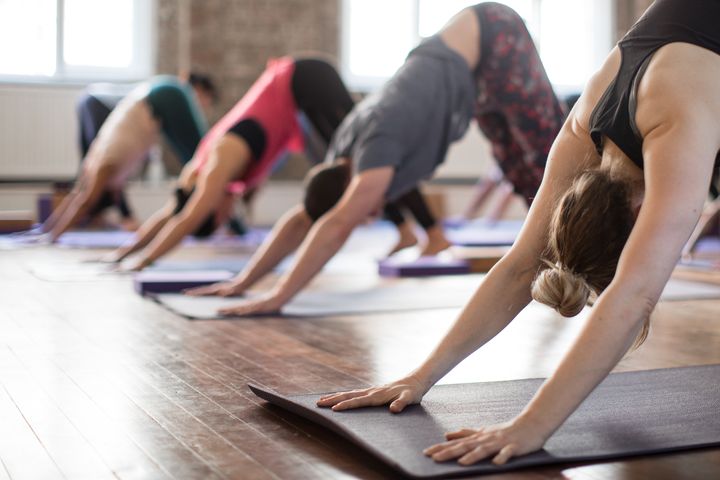
You’re reading Move, the nudge we need to get active, however makes us happiest and healthiest.
When you think of yoga, you probably immediately picture the downward facing dog pose – or Adho Mukha Svanasanaas, as it’s called in Sanskrit. It’s widely considered as the mother of all yoga poses. Even non-yogis tend to know it.
The downward dog is great for strengthening your body, as well as providing balance for mind and body. And it can easily be snuck in-between tea breaks if you’re still working from home (guilty).
“The pose enhances flexibility in the shoulders, hips and thoracic spine,” says Naomi Annand, author of Yoga: a Manual for Life and founder of east London yoga studio Yoga on the Lane. “It lengthens the hamstrings and calves and strengthens the long spinal muscles, quadriceps, rotator cuff, and triceps to name just the main muscle groups used.”
Think of it as a mind and body MOT. Bodies respond well to doing things little and often, so even if you don’t have 90-minutes, you can squeeze in a stretch here and there. “Every time you do yoga, you’re building resilience and creating new little imprints in your nervous system,” adds Annand.
However famous the pose may be, it’s quite an intense posture and there’s a lot to pay attention to. So, here’s how to make sure you’re doing it properly.
1. Align your body correctly
As one of the more well-known yoga poses, the downward facing dog gives off the impression that it’s a straightforward pose, says Triyoga teacher, Christian Di Giorgio. But many people slip into misalignments.
The focus should be on lengthening the trunk and visualising an inverted “V” shape with your body, he says, with the coccyx at the apex. “Beginners should keep the arms locked and use them to press the spine and hips up and back whilst straightening the legs to lift the tail bone higher.”
2. Keep enough space between your hands and feet
Di Giorgio says not keeping enough space between the hands and feet is a common mistake he sees in yoga classes. “This forces the spine to curve and compress instead of lengthening healthily as it should,” he says.
So, how much space should you keep? “You should aim to use much more of the mat when doing downward facing dog,” he tells HuffPost UK.
“Lie on your front with the toes tucked under and the finger tips level with the collar bones and lift up from there. An overly short stance can require too much stretch on the back and leg muscles, causing the spine to bulge outwards as it would when slumping in a chair. We are trying to correct the problems of long sitting not exacerbate them!”
3. Don’t fixate on putting your heels down
Many people have a fixation on getting their heels down, flat to the floor, when doing the pose, adds Di Giorgio. “Forget putting your heels on the floor,” he says, “this is advanced work!”
While placing the heels down firmly gives a good grounding in the pose, Di Giorgio says this is more like a “cherry on the cake”.
“Over months and years, as hamstrings and calves lengthen then students should strive to get the heels down but not at the expense of compromising the spine.”

4. Look after your wrists
It’s important to look after hands and wrists which, over time, can cause injury. “Some tend to lean heavily on the wrist bones which are not designed to bear weight, leading to potential repetitive strain injuries,” says Di Giorgio.
“They should try to spread the palms and fingers and press them strongly into the mat. This forces the forearm muscles to be more active and offloads the wrist bones.”
5. Adjust the pose to your level if needed
If you’re finding the pose difficult, keep in mind you can tailor it to your abilities. “You might not be as able-bodied or want to throw yourself into such a dramatic stretch, but there are alternatives like the puppy pose, which is the downward dog, but on the knees,” says Annand. “It’s a little more gentle.”
There are also options to make it more advanced. “Try more broadening of the shoulders and opening of the armpits and chest, so that the lungs can remain open and free whilst keeping the neck passive,” suggests Di Giorgio.
“The abdomen and pubic area should be more lifted and toned as the waist lengthens much more. Work the calves and ankles harder to ground the heels without compromising the extension of the spine.”
Move celebrates exercise in all its forms, with accessible features encouraging you to add movement into your day – because it’s not just good for the body, but the mind, too. We get it: workouts can be a bit of a slog, but there are ways you can move more without dreading it. Whether you love hikes, bike rides, YouTube workouts or hula hoop routines, exercise should be something to enjoy.
